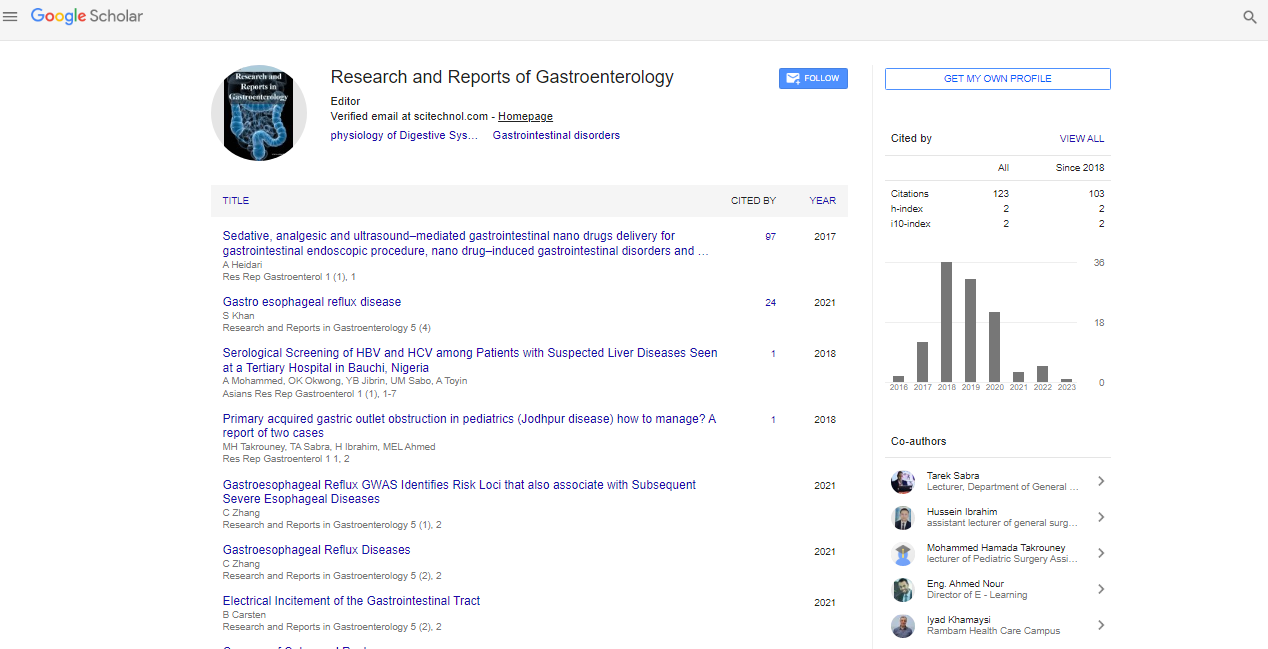Commentary, Res Rep Gastroenterol Vol: 7 Issue: 4
Adenomatous Polyps: Understanding the Precursors to Colorectal Cancer
Lianhua Fei*
1Department of Ultrasound, First Medical Center, Chinese PLA General Hospital, Beijing, China
*Corresponding Author: Lianhua Fei,
Department of Ultrasound, First
MedicalCenter, Chinese PLA General Hospital, Beijing, China
E-mail: feilianhua@gmail.com
Received date: 20 November, 2023 Manuscript No. RRG-24-124063;
Editor assigned date: 22 November, 2023, PreQC No. RRG-24-124063 (PQ);
Reviewed date: 06 December, 2023, QC No. RRG-24-124063;
Revised date: 13 December, 2023, Manuscript No. RRG-24-124063 (R);
Published date: 20 December, 2023, DOI: 10.4172/Rrg.1000159
Citation: Fei L (2023) Adenomatous Polyps: Understanding the Precursors to Colorectal Cancer. Res Rep Gastroenterol 7:4.
Description
Adenomatous polyps, growths that develop on the inner lining of the colon or rectum, are significant precursors to colorectal cancer a leading cause of cancer-related deaths worldwide. These polyps are often discovered during routine screening procedures such as colonoscopies and play a crucial role in our understanding of colorectal cancer prevention.
Characteristics of adenomatous polyps
Adenomatous polyps are a type of colorectal polyp that can vary in size and shape. They are characterized by the presence of abnormal growths on the inner lining of the colon or rectum, and they have the potential to transform into cancer over time. Adenomatous polyps are further categorized into three main subtypes: Tubular adenomas, tubulovillous adenomas, and villous adenomas. The degree of risk associated with each subtype is influenced by factors such as size, architecture, and the presence of dysplasia.
Several factors contribute to the development of adenomatous polyps, including age, family history, and lifestyle choices. The risk of developing these polyps increases with age, and they are more commonly found in individuals over the age of 50. A family history of colorectal polyps or cancer, particularly in first-degree relatives, also elevates the risk. Lifestyle factors such as a diet high in red and processed meats, low fiber intake, smoking, and excessive alcohol consumption are associated with an increased risk of adenomatous polyps.
The detection of adenomatous polyps is primarily achieved through screening methods, with colonoscopy being the gold standard for both detection and removal. During a colonoscopy, a flexible tube with a camera is inserted into the colon, allowing the healthcare provider to visualize the inner lining and identify any polyps. Other screening methods, such as flexible sigmoidoscopy and stool tests, may also be used to detect the presence of polyps, although they may not provide the same level of comprehensive examination as colonoscopy.
Importance of early intervention
Early intervention is crucial when adenomatous polyps are detected, as it offers the opportunity to remove the polyps before they progress to colorectal cancer. Polypectomy, the removal of polyps during a colonoscopy, is a common and effective procedure that not only addresses existing polyps but also reduces the risk of developing colorectal cancer in the future. Regular screening and timely removal of adenomatous polyps play a vital role in preventing the transformation of these growths into malignancies.
Adenomatous polyps are considered precursors to colorectal cancer, and the risk of cancer development is directly correlated with the characteristics of the polyps. Larger polyps, those with a villous component, and those exhibiting high-grade dysplasia are associated with an increased risk of colorectal cancer. Regular screening is paramount, as it allows for the early detection and removal of polyps, thus preventing the progression to cancer.
Adopting a healthy lifestyle can contribute significantly to reducing the risk of adenomatous polyps and colorectal cancer. Dietary modifications, including an increase in fiber-rich foods, fruits, and vegetables, and a reduction in red and processed meats, can have a positive impact. Regular physical activity, maintaining a healthy weight, and avoiding tobacco and excessive alcohol use are also important lifestyle choices that contribute to overall colorectal health.
Adenomatous polyps serve as critical indicators in the prevention of colorectal cancer, emphasizing the importance of regular screenings and early intervention. Understanding the risk factors associated with these polyps allows individuals and healthcare providers to implement effective preventive measures and lifestyle changes. With the advent of screening technologies and increased awareness, the goal of minimizing the impact of adenomatous polyps on colorectal health is within reach. As research continues to unveil insights into colorectal cancer prevention, the emphasis on early detection and intervention remains a cornerstone in the fight against this prevalent and potentially lethal disease.
 Spanish
Spanish  Chinese
Chinese  Russian
Russian  German
German  French
French  Japanese
Japanese  Portuguese
Portuguese  Hindi
Hindi 